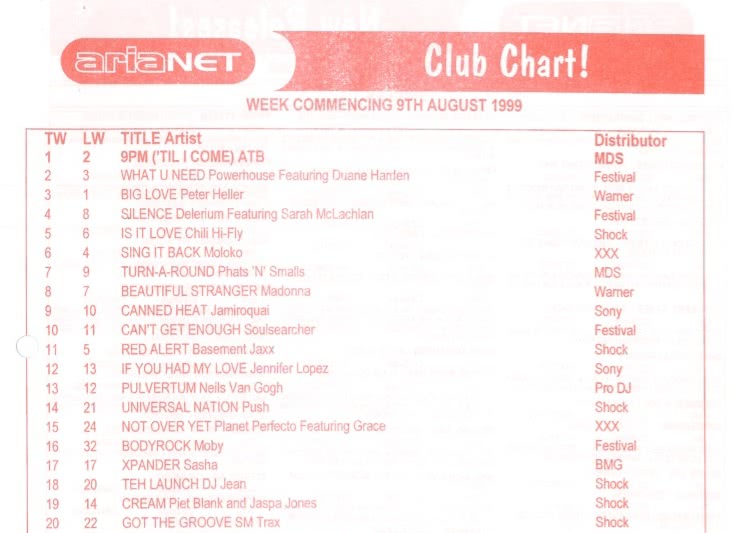20 Years of the ARIA Club Chart: A deep dive

What were you partying to in 1999? If Pete Heller’s ‘Big Love’ or ATB’s ‘9PM (‘Til I Come)’ was blasting from your turntable, you weren’t alone.
On July 26, 20 years ago, ARIA published its weekly club chart for the very first time, an age well before EDM swept the United States like a sweaty fever. And some years out from the arrival of the giant, dance-leaning festivals and the digital revolution.
U.K. producer Pete Heller owned that first chart with ‘Big Love,’ in a time when DJs ruined their backs carrying road cases full of vinyl and raves were still the business.
Pete Heller, ‘Big Love’:
Some things never change. Vinyl sales are surging. And in a cute twist, Heller rules the current chart with a 20-year anniversary remix.
The weekly tally was launched along the lines of the established Billboard Dance Club Songs chart, to reflect what was being played in dance clubs. ARIA surveyed 127 DJs for the early version of its weekly dance tally, then a top 40.
Today, it’s a top 50 and its data remains based on DJ reports. Australian acts are pumping, with 33 artists impacting the current chart, against just one (Chili Hi-Fly) in the inaugural survey.

Old school. The second ever ARIA Club Chart
To celebrate its big milestone, ARIA opened the vault on the two decades of its ARIA Club Chart.
TIO can reveal Calvin Harris holds the record for most No. 1 Club tracks with seven, while the first Australian No. 1 ARIA Club Track was ‘Don’t Call Me Baby’ by Madison Avenue, which also holds the record for the longest stint at No. 1, with 18 consecutive weeks.
“Over the last two decades we have seen dance music leave the clubs and dominate the mainstream charts,” comments ARIA Chief Executive Dan Rosen.
“As respect and awareness for dance music has grown, ARIA remains committed to the club scene. It is an important and powerful breeding ground for today’s aspiring DJs and tomorrow’s megastars. I’d also like to thank everyone from the ARIA Club Chart Committee over the years for their hard work.”
ARIA tapped a line-up of artists for a special video, which can be seen below. In it, Inaya Day, Sneaky Sound System, Madison Avenue’s Andy Van, Timmy Trumpet and others send on their birthday well-wishes and thanks for support.
SSS’s Connie Mitchell pays tribute to ARIA and its charts which, she says, has “been very integral to our journey as artists and without you we wouldn’t be where we are today.”
20 Years of the ARIA Club Chart:
The year 1999 was the dawn of a cracking era for Australian dance and electronic artists.
Melbourne DJ Anthony Pappa was one of the world’s elite DJs. Paul Mac was on his way and the likes of Pnau, Peking Duk and many others were starting to find their groove.
Dance and electronic music was finally bubbling up from the underground in these parts and Aussie producers were delivering hits across borders, none bigger than ‘Don’t Call Me Baby’.
In May 1999, Andy Van Dorsselaer and singer Cheyne Coates teamed up as Madison Avenue and ruled the U.K. singles chart with the funky house hit (it reached No. 2 on the ARIA Singles Chart). Later, they dropped the U.K. top 10 release ‘Who The Hell Are You?’
Madison Avenue, ‘Don’t Call Me Baby’:
https://www.youtube.com/watch?v=Tn-qE-h7s84
Carl Cox, the superstar British DJ who digs Australia so much he owns a property on the Mornington Peninsula, let his love flow with the 2000 beat-mixed release F.A.C.T. Australia, an ode to clubland.
The following year, the Avalanches’ cut ‘n’ paste masterwork Since I Left You went top 10 on the U.K. albums chart, and earned a place in the NME‘s list of the great albums of the decade.
The following year, in 2002, ‘Addicted to Bass’ (as Puretone and Amiel Daemion) hit No. 2 and was unlucky to hit the summit. It might have, if a handful of U.K. retailers hadn’t broken the embargo and sold the record a week early (those sales combined with the official first week number would have been enough to secure top spot).
Puretone – ‘Addicted to Bass’:
https://www.youtube.com/watch?v=jU4VuN9EW9U
Natalie Bassingthwaighte and the Rogue Traders went to No. 3 in 2006 with “Voodoo Child.”
“In the past 20 years we have seen dance music go from a club thing, to a rich and legitimate genre inspiring all walks of life,” explains Gabby Colombi, ARIA Club Chart Committee Member since 1999.
“The ARIA Club Chart remains a voice for individuals, DJs, producers, women and independents working for the good of the dance community.”
This article originally appeared on The Industry Observer, which is now part of The Music Network.






























